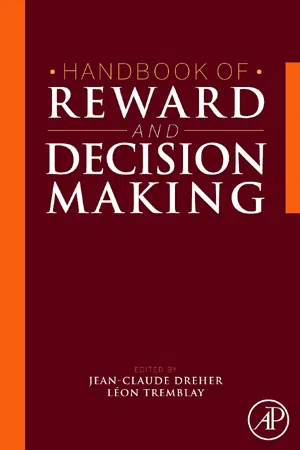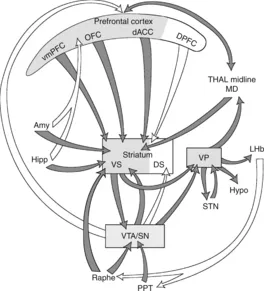
- 526 pages
- English
- ePUB (mobile friendly)
- Available on iOS & Android
Handbook of Reward and Decision Making
About This Book
This book addresses a fundamental question about the nature of behavior: how does the brain process reward and makes decisions when facing multiple options? The book presents the most recent and compelling lesion, neuroimaging, electrophysiological and computational studies, in combination with hormonal and genetic studies, which have led to a clearer understanding of neural mechanisms behind reward and decision making. The neural bases of reward and decision making processes are of great interest to scientists because of the fundamental role of reward in a number of behavioral processes (such as motivation, learning and cognition) and because of their theoretical and clinical implications for understanding dysfunctions of the dopaminergic system in several neurological and psychiatric disorders (schizophrenia, Parkinson's disease, drug addiction, pathological gambling, ...)
- Comprehensive coverage of approaches to studying reward and decision making, including primate neurophysiology and brain imaging studies in healthy humans and in various disorders, genetic and hormonal influences on the reward system and computational models.
- Covers clinical implications of process dysfunction (e.g., schizophrenia, Parkinson's disease, eating disorders, drug addiction, pathological gambling)
- Uses multiple levels of analysis, from molecular mechanisms to neural systems dynamics and computational models.
" This is a very interesting and authoritative handbook by some of the most outstanding investigators in the field of reward and decision making ", Professor Edmund T. Rolls, Oxford Center for Computational Neuroscience, UK
Frequently asked questions
Information
Suzanne N. Haber
Key Points
1.1. Introduction
 |
| Figure 1.1 Schematic illustrating key structures and pathways of the reward circuit. Shaded areas and gray arrows represent the basic ventral cortico-BG structures and connections. Amy, amygdala; dACC, dorsal anterior cingulate cortex; DPFC, dorsal prefrontal cortex; DS, dorsal striatum; Hipp, hippocampus; hypo, hypothalamus; LHb, lateral habenula; OFC, orbital frontal cortex; PPT, pedunculopontine nucleus; SNc, substantia nigra, pars compacta; STN, subthalamic n.; Thal, thalamus; VP, ventral pallidum; VS, ventral striatum; VTA, ventral tegmental area; vmPFC, ventral medial prefrontal cortex. |
1.2. Prefrontal Cortex
Table of contents
- Cover Image
- Table of Contents
- Copyright
- Preface
- List of contributors
- Chapter 1. Anatomy and connectivity of the reward circuit
- Chapter 2. Electrophysiological correlates of reward processing in dopamine neurons
- Chapter 3. The ventral striatum
- Chapter 4. Role of the primate lateral prefrontal cortex in integrating decision-making and motivational information
- Chapter 5. From reward value to decision-making
- Chapter 6. Decomposing brain signals involved in value-based decision making
- Chapter 7. Reward processing in the human brain
- Chapter 8. Spatiotemporal characteristics of perceptual decision making in the human brain
- Chapter 9. Feedback valuation processing within the prefrontal cortex
- Chapter 10. Computational neuroimaging
- Chapter 11. Can models of reinforcement learning help us to understand symptoms of schizophrenia?
- Chapter 12. Effects of dopamine depletion on reward-seeking behavior
- Chapter 13. A neuropsychological perspective on the role of the prefrontal cortex in reward processing and decision-making
- Chapter 14. Gonadal steroid hormones’ influence on reward and decision-making processes
- Chapter 15. Hormone effects on specific motivational states and underlying CNS arousal
- Chapter 16. The genetic basis of individual differences in reward processing and the link to addictive behavior
- Chapter 17. Catechol-O-methyltransferase (COMT) genotype effects on brain activation elicited by affective stimuli and cognitive tasks
- Chapter 18. Optimal decision-making theories
- Chapter 19. The basal ganglia in reward and decision making
- Chapter 20. Reward-based emotions
- Chapter 21. Bayesian decision making in two-alternative forced choices
- Chapter 22. Predicting risk in a multiple stimulus-reward environment
- Index